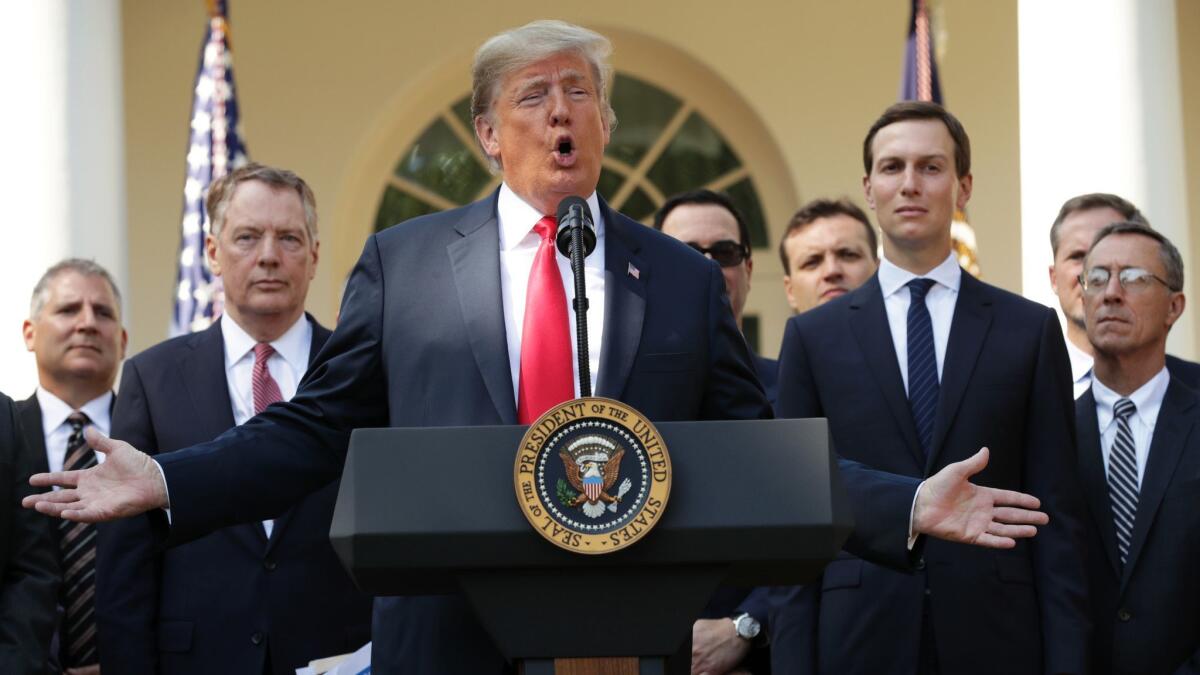Trump calls revamped NAFTA a new model for U.S. trade relations, but others see it as just an update

- Share via
Reporting from Washington — President Trump on Monday lauded the new trade accord with Canada and Mexico as the most important ever for the United States and “a historic win” for American farmers, manufacturers and autoworkers.
Although the overhaul contains substantial updates to the North American Free Trade Agreement as well as potentially significant improvements and some innovations, few trade experts see the newly negotiated deal as fundamentally different from the original quarter-century-old pact.
Trump’s chief negotiator, Robert Lighthizer, singled out new rules for auto trade as a big win that will bring back jobs to the United States. Analysts, however, said those changes were likely to yield only marginal help for domestic carmakers and workers in the foreseeable future.
“This is not a radically new thing,” said Frederick Mayer, a public policy professor at Duke University who worked on NAFTA in the early 1990s for then-Sen. Bill Bradley. “This is a sensible, reasonable adjustment, modernization, that maintains the central core of NAFTA.”
Lawmakers, businesses, labor and other groups reacted cautiously to the deal, saying they were still reviewing the 1,168-page text of the newly named U.S.-Mexico-Canada Agreement, or USMCA. The document was posted moments after the U.S. and Canada announced a breakthrough to beat the U.S.-imposed Sunday midnight deadline, essentially salvaging the trilateral trade pact from a possible breakup.
In concluding negotiations with Canada and Mexico, Trump moved close to fulfilling a top campaign promise to redo a trade pact that he frequently denounced as a “disaster.” Trump and the leaders of Canada and Mexico are now expected to sign the deal Nov. 30. Senior administration officials expect a vote next year in Congress, where prospects for approval remain unclear.
The agreement includes a dozen new chapters, including on labor and the environment, which in the original pact were mere side agreements. There are fresh or expanded sections on digital trade, financial services, state-owned enterprises and intellectual property.
Analysts noted that major portions were borrowed from or built on provisions in the Trans-Pacific Partnership, the 12-nation trade pact completed by President Obama that Trump promptly killed when he became president. The U.S., Canada and Mexico were part of that Pacific Rim accord.
Lighthizer acknowledged as much in a briefing with reporters Monday, joined by Trump’s son-in-law Jared Kushner, who helped mediate the trade talks. But Lighthizer said “our agreement is substantially better” than the Trans-Pacific Partnership.
U.S. negotiators delivered some solid gains for U.S. farmers, particularly by prying open a little more of Canada’s tightly controlled dairy market, especially dry milk. And Canada also bent to U.S. demands for 10 years of patent exclusivity protection for biologic drugs, two more years than what was negotiated in the Trans-Pacific Partnership. Drugmakers sought the longer exclusivity term, but consumer advocates argued that the extended period would hurt patients by delaying the marketing of generic drugs.
“There’s a spirited debate going on in Canada, but the overall sentiment is relief that there’s a deal to be done,” said Daniel Ujczo, an international trade lawyer who specializes in Canada-U.S. affairs at the law firm Dickinson Wright.
Ujczo said the Trump administration was never “red in tooth and claw” about radically transforming NAFTA in the first place. That was a false narrative, he said. “The reality was they wanted to renovate the agreement.” Ujczo said the big win for Trump was political.
Yet at the Rose Garden event Monday to celebrate the new pact, Trump — whose hardball negotiating tactics strained relations with the two U.S. trading partners — bristled at those who said his efforts largely amounted to an update of the existing agreement. “It’s not NAFTA redone,” he said. “It’s a brand-new deal.”
Since NAFTA took effect in 1994, trade among the three North American nations has jumped to more than $1.2 trillion. And if the new agreement is ratified, all three countries are expected to benefit from an updating of rules and procedures governing customs, border issues, digital trade and other measures cutting red tape.
“It’s significant and a good thing,” said William Reinsch, a veteran trade expert and senior advisor at the think tank Center for Strategic and International Studies. Still, he added, “It’s not radically different.”
On some of the biggest and controversial issues, the Trump administration had mixed results. Some key provisions were left largely intact, including those related to government procurement and a dispute-resolution mechanism.
Perhaps the single biggest and most innovative change came in auto rules, which took up the largest amount of negotiating time. The auto industry welcomed a deal that included all three countries, fearing a breakup of NAFTA would devastate long-built supply chains that cut across borders. Trump had threatened to proceed with Mexico alone if an agreement with Canada could not be reached by Sunday.
The provision requiring 75% of a vehicle’s content be produced in North America to qualify for tariff-free trade — up from 62.5% — and a new requirement that 40% to 45% of a vehicle’s content must be produced by workers making at least $16 an hour are likely to help lure auto manufacturing to the U.S.
But the deal is unlikely to lead to a significant boost for U.S. automaker factories, said Kristin Dziczek, vice president of industry, labor and economics at the Center for Automotive Research, a nonprofit research group.
“I don’t see a lot of investment or jobs coming back here as a result,” Dziczek said. “On the margins, you’ll see some.”
She added that U.S. auto sales have been declining since hitting a record 17.55 million in 2016, so the industry has excess manufacturing capacity here.
Many automakers have moved production to Mexico, which will feel the biggest effect from the new auto rules. Still, Luis Videgaray, Mexico’s secretary of foreign affairs, expressed satisfaction with the overall deal.
“This is good news for Mexico,” he said Monday in a radio interview. “It gives certainty to the Mexican economy, and to commerce and investment, and maintains the integrity of what should be the most competitive region of the world.”
The Trump administration’s focus on autos was in part to address the flight of jobs to Mexico but also the president’s repeated complaints about the U.S. trade deficit with Mexico and other countries. Auto trade accounts for the bulk of the deficit. Experts doubt the new auto rules and the revised trade pact overall will have a significant bearing on the trade balance.
After the three leaders sign the deal at the end of November, an independent economic assessment needs to be issued before the agreement can be taken to Congress for a vote. Analysts expect that will happen in the spring.
Trump said “there should be no trouble” getting the deal approved by Congress, but added that there could be problems if Democrats gain control of the House or the Senate in the November elections. “I think it’ll pass easily, really easily, because it’s a great deal,” he said.
But the politics of trade are complicated and cut across party lines. Key Republicans expressed optimism even as they acknowledged they still needed to analyze the details. Rep. Kevin Brady (R-Texas) said a modernized NAFTA “can be a big win for America’s workers, farmers and ranchers.”
Democrats were more circumspect. House Democratic Leader Nancy Pelosi (D-San Francisco) promised that members of her party “ will closely scrutinize” the deal’s text and will judge it “by whether it improves the wages, working conditions and well-being of America’s workers and farmers.”
Lighthizer consulted closely with both parties during the yearlong negotiations and said Monday that he believed the deal would get significant support. Many congressional Democrats have been critical of NAFTA, blaming it for spurring offshoring of jobs to Mexico, with its low wages and poor labor rights.
The labor provisions in the new agreement — including some to bolster workers’ organizing rights in Mexico — “are more progressive than ever negotiated by anybody else,” Lighthizer said.
Analysts agreed that the labor chapter in the new agreement is stronger than those in the Trans-Pacific Partnership, which many unions and labor groups panned. Still, for both labor and environment standards set out in the new accord, labor unions and other groups said it was unclear whether the provisions had strong enforcement rules tied to them.
“Added protections for working people and some reductions in special privileges for global companies is a good start, but we still don’t know whether this new deal will reverse the outsourcing incentives present in the original NAFTA,” Richard Trumka, president of the AFL-CIO, said in a statement. “It also is critical that we see what final labor enforcement, auto rules of origin and government purchasing provisions will look like.”
Times staff writers Patrick J. McDonnell in Mexico City and Sarah D. Wire in Washington contributed to this report.
Follow me at @dleelatimes
UPDATES:
6:05 p.m.: This article was updated with reaction from experts and analysis.
This article was originally published at 10:40 a.m.
More to Read
Inside the business of entertainment
The Wide Shot brings you news, analysis and insights on everything from streaming wars to production — and what it all means for the future.
You may occasionally receive promotional content from the Los Angeles Times.












